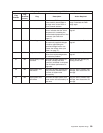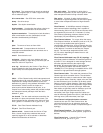drive head. The component that records an electrical
signal onto magnetic tape, or reads a signal from tape
into an electrical signal.
drive sense data. See SCSI drive sense data.
dump. See drive dump.
duplex. See duplex transmission.
duplex adapter. A mechanism that allows a device to
send and receive communication at the same time.
duplex transmission. Transmission in both directions,
either one direction at a time (half-duplex) or both
directions simultaneously (full-duplex).
E
eject. To remove or force out from within.
electronic mail. Correspondence in the form of
messages transmitted between user terminals over a
computer network.
e-mail. See electronic mail.
enclosure. A device, such as a desktop unit, tape
cartridge autoloader, or tape library, into which you can
install the Ultrium 2 Tape Drive.
error log. Maintained by the Ultrium 2 Tape Drive, a
list that contains the ten most recent error codes. The
codes identify errors that pertain to the drive.
F
fabric. A Fibre Channel entity which interconnects and
facilitates logins of N_ports that attach to it. The fabric is
responsible for routing frames between source and
destination N_ports by using address information in the
frame header. A fabric can be as simple as a
point-to-point channel between two N-ports, or as
complex as a frame-routing switch that provides multiple
and redundant internal pathways within the fabric
between F_ports.
fan shroud. The wire mesh enclosure around the fan
that holds it in place and prevents direct access. The
shroud mounts the fan assembly to the Ultrium 2 Tape
Drive. generic FC reference to an N_port or an F_port.
FC-AL. See Fibre Channel-Arbitrated Loop.
FC port. See Fibre Channel port.
feature switch. Located under the Ultrium 2 Tape
Drive, a bank of eight micro switches that can be
manually toggled on or off to activate or deactivate
different characteristics of the drive.
fiber optic cable. The medium by which light is
transmitted through fibers or thin rods of glass or some
other transparent material of high refractive index.
fiber optics. A branch of optics dealing with the
transmission of light through fibers or thin rods of glass
or some other transparent material of high refractive
index.
Fibre Channel. A 100-MB-per-second, full-duplex,
serial communications technology that is capable of
interconnecting Ultrium 2 Tape Drives and servers which
are separated by as much as 11 kilometers (7 miles).
Fibre Channel technology combines features of the
input/output (I/O) and networking interfaces.
Fibre Channel address. For a tape drive that uses a
Fibre Channel interface, an identifier (such as an AL_PA
or Loop ID) that enables other device ports to
communicate with that drive. A Fibre Channel drive has
a 3-byte address. The switch assigns the upper 2 bytes
of the address. If no switch is attached, the 2 bytes
equal 0. The lower byte assignment (which is the
AL_PA) varies, depending on whether hard or soft
addressing is used.
Fibre Channel-Arbitrated Loop (FC-AL) topology. A
serial data-transfer architecture and standard governed
by ANSI. FC-AL is designed for mass storage devices
and other peripheral devices that require high
bandwidth. By using optical fiber to connect devices,
FC-AL supports full-duplex data transfer rates of
100MBps. An FC-AL topology is compatible with a SCSI
interface for high-performance storage systems.
Fibre Channel cable. The cable that connects a Fibre
Channel tape drive to another device. The conductive
element within the cable is constructed of either copper
wires or optical fibers. Generally, copper wires are used
for short distances (up to 30 meters or 98 feet); optical
fibers are used for longer distances. Fiber-optic cabling
is referred to by mode or the frequencies of light waves
that are carried by a particular cable type. Multimode
fiber cables are generally used for distances up to 500
meters (1640 feet) and with short-wave (780
nanometer) laser light. Single-mode fiber cables are
used for distances greater than 500 m (1640 feet) and
with long-wave (1300 nanometer) laser light.
Fibre Channel configuration/status connector.
Located at the rear of a Fibre Channel drive, the
connector that allows you to optionally change the
drive’s link services (for example, its speed and type of
topology).
Fibre Channel interface. The hardware or software
that links differing Fibre Channel systems, programs or
devices.
Fibre Channel port. A generic Fibre Channel
reference to an N_port or an F_port.
Glossary 107


















